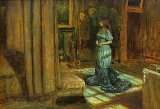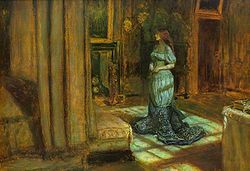
The Eve of St. Agnes
Encyclopedia

John Keats
John Keats was an English Romantic poet. Along with Lord Byron and Percy Bysshe Shelley, he was one of the key figures in the second generation of the Romantic movement, despite the fact that his work had been in publication for only four years before his death.Although his poems were not...
, written in 1819
1819 in poetry
Nationality words link to articles with information on the nation's poetry or literature .-Events:* The period from September 1818 to September of this year is often referred to among scholars of John Keats as "the Great Year", or "the Living Year", because during this period he was most...
and published in 1820
1820 in poetry
Nationality words link to articles with information on the nation's poetry or literature .-Events:* Formation of the Apostles, a Cambridge University intellectual society...
. It is widely considered to be amongst his finest poems and was influential in 19th century literature. The poem is in Spenserian stanzas
Spenserian stanza
The Spenserian stanza is a fixed verse form invented by Edmund Spenser for his epic poem The Faerie Queene. Each stanza contains nine lines in total: eight lines in iambic pentameter followed by a single 'Alexandrine' line in iambic hexameter. The rhyme scheme of these lines is...
.
The title comes from the day (or evening) before the feast of Saint Agnes
Saint Agnes
Agnes of Rome is a virgin–martyr, venerated as a saint in the Roman Catholic Church, Eastern Orthodox Church, the Anglican Communion, and Lutheranism. She is one of seven women, excluding the Blessed Virgin, commemorated by name in the Canon of the Mass...
(or St. Agnes' Eve). St. Agnes, the patron saint of virgins, died a martyr
Martyr
A martyr is somebody who suffers persecution and death for refusing to renounce, or accept, a belief or cause, usually religious.-Meaning:...
in fourth century Rome. The eve falls on January 20; the feast day on the 21. The divinations referred to by Keats in this poem are referred to by John Aubrey
John Aubrey
John Aubrey FRS, was an English antiquary, natural philosopher and writer. He is perhaps best known as the author of the collection of short biographical pieces usually referred to as Brief Lives...
in his Miscellanies (1696) as being associated with St. Agnes' night.
Background
Keats based his poem on the superstition that a girl could see her future husband in a dream if she performed certain rites on the eve of St. Agnes; that is she would go to bed without any supper, undress herself so that she was completely naked and lie on her bed with her hands under the pillow and looking up to the heavens and not to look behind. Then the proposed husband would appear in her dream, kiss her, and feast with her.A Scottish version of the ritual would involve young women meeting together on St. Agnes's Eve at midnight, they would go one by one, into a remote field and throw in some grain, after which they repeated the following rhyme in a prayer to St. Agnes:
“ Agnes sweet, and Agnes fair,
Hither, hither, now repair;
Bonny Agnes, let me see
The lad who is to marry me. ”
In the original version of his poem, Keats emphasized the young lovers' sexuality, but his publishers, who feared public reaction, forced him to tone down the eroticism.
Plot

Beadsman
Bedesman, or beadsman was generallya pensioner or almsman whose duty it was to pray for hisbenefactor....
performs his penances while in the castle of Madeline's warlike family, a bibulous revel has begun. Madeline pines for the love of Porphyro, sworn enemy to her kin. The old dames have told her she may receive sweet dreams of love from him if on this night, St. Agnes' Eve, she retires to bed under the proper ritual of silence and supine receptiveness.
As we might expect, Porphyro makes his way to the castle and braves entry, seeking out Angela, an elderly woman friendly to his family, and importuning her to lead him to Madeline's room at night where he may but gaze upon her sleeping form. Angela is persuaded only with difficulty, saying she fears damnation if Porphyro does not afterward marry the girl.
Concealed in an ornate carven closet in Madeline's room, Porphyro watches as Madeline makes ready for bed, and then, beholding her full beauty in the moonlight, creeps forth to prepare for her a feast of rare delicacies. Madeline wakes and sees before her the same image she has seen in her dream, and thinking Porphyro part of it, receives him into her bed. Awakening in full and realizing her mistake, she tells Porphyro she cannot hate him for his deception since her heart is so much in his, but that if he goes now he leaves behind "A dove forlorn and lost / With sick unpruned wing".
Porphyro declares his love for Madeline and promises her a home with him over the southern moors. They escape the castle past insensate revelers, and flee into the night. The beadsman, "His thousand Aves told / For aye unsought-for slept among his ashes cold".
External links
- 'St. Agnes Eve', Text of 'St. Agnes' Eve' by Keats from Bartleby.
- 'The Eve of St. Agnes' at Internet ArchiveInternet ArchiveThe Internet Archive is a non-profit digital library with the stated mission of "universal access to all knowledge". It offers permanent storage and access to collections of digitized materials, including websites, music, moving images, and nearly 3 million public domain books. The Internet Archive...
(scanned books color illustrated). Notable editions:- 'The Eve of St. Agnes' (1900) calligraphy by Ralph Fletcher SeymourRalph Fletcher SeymourRalph Fletcher Seymour was an American artist, author, and publisher of the late nineteenth and the twentieth centuries...
, "Introduction" by Edmund GosseEdmund GosseSir Edmund William Gosse CB was an English poet, author and critic; the son of Philip Henry Gosse and Emily Bowes.-Early life:... - 'The Eve of St. Agnes' (1885) illus. by Edmund H. GarrettEdmund H. GarrettEdmund Henry Garrett was an American illustrator, bookplate-maker, and author—as well as a highly respected painter—renowned for his illustrations of the legends of King Arthur.-Biography:Garrett was born in Albany, New York on October 19, 1853...
- 'The Eve of St. Agnes' (1900) calligraphy by Ralph Fletcher Seymour
- The Theme of "The Eve of St. Agnes" in the Pre-Raphaelite Movement, An analysis of the poem at Victorianweb
- CUNY Brooklyn page on the Eve of St Agnes

